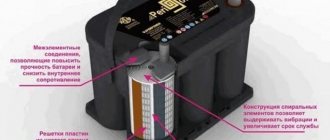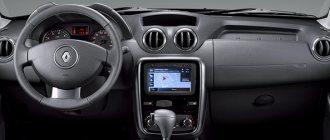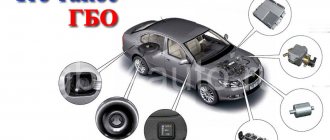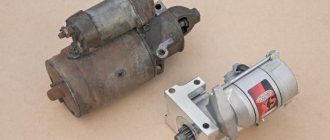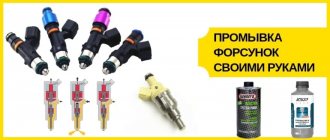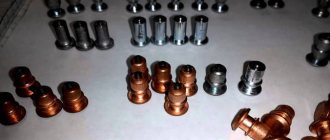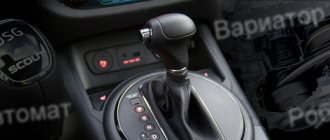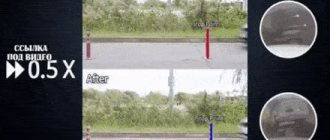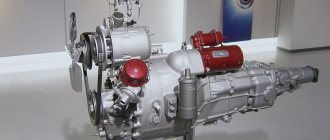05/14/2021 29,057 automatic transmission
Author: Ivan Baranov
Currently, cars are equipped with gearboxes of various types; probably more than ten alternatives are offered to the modern car enthusiast to choose from. Which one to choose is a purely individual matter, but, of course, you want the most convenient and reliable one, and it is on the question of which is better, Tiptronic or automatic, that the heated discussions are taking place.
Each type of gearbox has its own positive and negative sides, and you can argue on this topic endlessly - it all depends on personal preference and on the conditions in which the car will be used. Much also depends on the skills and experience of the driver.
[Hide]
Difference between tiptronic and automatic
Despite the fact that tiptronic has already firmly entered the lives of many domestic car enthusiasts, the debate about which is better: the good old automatic or the trendy tiptronic still continues.
The domestic auto world is divided into two camps, one of which is made up of adherents of the usual automatic transmission, the pros and cons of which have long been studied and known to everyone. Oppositional tiptronic fans confidently declare that we need to keep up with the times, and an automatic transmission is a thing of the past.
In order to figure out what is better, tiptronic or automatic, you need to find out the features and significant differences between both types of gearboxes.
Definition
An automatic transmission is a car gearbox that is capable of independently, without driver intervention, changing gears while the car is moving.
Tiptronic is an automatic transmission of a special design, thanks to which downshifts are carried out in automatic mode, and upshifts can also be done manually.
The main difference between an automatic and a tiptronic is that the automatic transmission is, in principle, deprived of the ability to change gears manually. Tiptronic not only works in conventional automatic transmission mode, but also has the advantages of mechanics. For this purpose, the tiptronic provides a manual option for switching speeds.
Automatic transmission
This feature seems to be a significant advantage of the tiptronic over the automatic in terms of functionality. However, you will have to pay a hefty sum for a tiptronic; an automatic is much cheaper.
But tiptronic allows the driver to take full control if necessary, for example, when driving on dirt roads and other difficult areas.
Also, the tiptronic is ahead of the automatic in terms of dynamics - if you need to overtake, the tiptronic can easily be transformed into a manual transmission and pick up speed faster than the automatic.
The advantages of tiptronic are especially noticeable in winter, when there is often a need for engine braking. An automatic machine cannot do this.
At the same time, simple control of the automatic transmission is accessible even to a novice, who is unlikely to appreciate the advantages of tiptronic, unlike an experienced driver.
Comparative characteristics
Classic automatic transmission
| Classic automatic transmission | |
| Positive characteristics | Flaws |
| Exceptional ease of operation, resulting in much less driver fatigue, especially in urban driving | It is not recommended to start a car with an automatic transmission, as they say, from a pusher. But some still neglect this rule and in vain |
| Smaller dimensions than Tiptronic | The automatic transmission is not suitable for driving on bad roads |
| Automatic transmission is much cheaper than Tiptronic | Frequent slipping on ice, especially during starting, leads to failure of some parts and even systems |
| No dips in motor traction | Frequent automatic transmission breakdowns in cold weather |
| Gentle engine operating modes | Speeds switch with a certain delay: from 0.1–0.7 seconds |
| Smooth operation, no jerking when changing gears | Undesirability of towing cars |
| Great option for novice drivers | It is undesirable to drive with trailers |
| It is undesirable to drive with trailers | |
| Harmfulness of acceleration overloads | |
| Expensive repairs | |
| Dear service | |
Tiptronic box
| Tiptronic | |
| Positive characteristics | Flaws |
| Cars with this gearbox can not only operate in the mode of an ordinary automatic gearbox, but also have all the positive qualities of mechanics | Significantly heavier than a conventional automatic transmission |
| Possibility of full control over transmission control while driving on dirt roads and other difficult areas | More expensive than usual |
| Better dynamics compared to an automatic - if necessary, this gearbox in manual transmission mode can pick up speed faster than an automatic one | |
| In winter, if necessary, engine braking is available; this is not possible with an automatic transmission. | |
| Easy automatic mode, understandable even for a beginner | |
| The automatic is more convenient during overtaking and maneuvers in difficult areas | |
| On bad roads and difficult terrain, the automatic transmission may not cope, but when switching to mechanical mode, the Tiptronic will overcome them easily | |
| Due to the combination of two types of automatic transmission, it is more versatile and functional | |
| Extremely useful when overtaking - in manual mode you can disable automatic upshifting | |
| In case of urgent engine braking, you can manually switch to a lower gear. This may be necessary to prevent skidding on icy roads. | |
| In winter mode, you can start on a slippery road immediately from 2nd speed, which will make it possible to prevent wheel slipping | |
| Since the automatic mode is not intended for driving on bad roads, switching to manual control mode makes it possible to some extent smooth out various potholes and bumps in the roads | |
| The design of this box provides a protection program against erroneous gear shifting | |
| Significantly saves fuel, even more than an automatic transmission | |
In any case, which automatic transmission to prefer is a choice for each individual, but still, if funds allow, then, of course, Tiptronic is preferable.
Loading …
What is the difference between an automatic transmission and a tiptronic?
The differences between a tiptronic and an automatic include several features. Automatic transmissions are all types of transmissions whose operation does not require mechanical engagement of the clutch by the driver. Tiptronic is only a subtype of automatic transmission, which has its own characteristics. This system was first tested by Porsche on its sports cars. Subsequently, this name was registered specifically for this company.
Essentially, the name tiptronic is used in the modern automotive industry as a common noun; other manufacturers have similar systems with their own names, but the operating principle is similar. This system is automatic, but has its own characteristics.
- Possibility of manual switching when moving the box selector to a certain position (designation M). In this case, the driver can switch to a higher or lower gear by switching the selector. This scheme is more widespread in a torque converter or robotic box, less common in a variator, where it only serves to simulate switching, since this type is stepless.
- A different design of the entire drive system. To introduce manual control functions into the overall design, Porsche had to make corrections to the operation of the automatic transmission. This affected both the torque converter unit and the solenoids, while the ability to select a manual gear directly affected the dynamics of the car. With this possibility, the speed indicators of such models are very close to their mechanical counterparts, and in terms of acceleration speed, similar models show identical dynamics.
The ease of control in manual mode is determined by the driver’s control of the gearbox, respectively, the traction and power of the engine, which ensures that the engine reaches its potential. This system has proven itself best on sports cars equipped with powerful engines. In earlier versions, the automatic transmission could not fully realize the engine's potential in terms of torque and maximum acceleration due to the imperfection of the electronics unit. This negative factor was smoothed out precisely by the manual control system.
In addition to the classic version with control on the gear shift knob, a scheme with steering wheel paddle shifters was subsequently introduced, which were located behind the steering wheel and provided greater comfort when moving. The innovation turned out to be so successful that all leading manufacturers of automatic transmissions gradually introduced similar systems into their products.
The unit can be turned on manually.
A classic automatic transmission that does not have such a mode has the following qualities in its arsenal:
- The absence of a manual mode simplifies the design, which directly affects the cost of the model on the market, as well as maintainability. Although most even budget models are equipped with this control system in manual mode. Repair work will cost an average of 20-25% less.
- The worst acceleration dynamics in comparison with tiptronic is due to the speed control process. In the classic version, in the absence of a manual mode, an electronic control unit is responsible for shifting gears, which regulates traction, as well as gear shifting itself. In this case, the driver actually cannot, except by controlling the gas pedal, influence the engine’s power performance, completely trusting the electronics. In emergency situations when overtaking on the highway or in the city, this can lead to dire consequences - an accident or the creation of an emergency situation.
- Due to the absence of tiptronic mode, an increased fuel appetite in the engine-transmission pair appears. Essentially, the amount of gasoline or diesel consumption does not depend on the driver; this parameter is controlled by the electronic control unit in conjunction with the engine.
The classic machine is shown in the photo.
Which is better: tiptronic or automatic?
To resolve the question of which system is better, it is necessary to determine the advantages and disadvantages of each of them and, accordingly, the differences between tiptronic and automatic:
- the automatic system without the use of manual switching is somewhat simpler in design, there are no guides for turning on the tiptronic;
- the simplicity of the design ensures an emphasis on reliability, as well as maintainability of the entire unit and system; depending on the type of gearbox (robot, variator, torque converter), they last 15% more than their competitors.
Features of operation
The operating features of such a system depend rather on the type of automatic transmission, each of which has its own characteristics:
- the CVT, equipped with a manual mode, only simulates gear shifting to increase driver comfort; Considering the continuously variable system, the presence of manual shifting is minimally expressed here and also gives minimal effect;
- a classic automatic allows you to fully realize the potential of the manual mode - so, depending on the unit, as well as its electronic firmware, this mode can provide more confident acceleration (on average by 0.5-1.5 seconds), and also save fuel in depending on the traffic situation;
- the presence of such a system in this unit is most justified in powerful cars with large engines.
A robotic gearbox is the most current gearbox for installing such a system. Considering the peculiarity of the work and, in most cases, the “thoughtfulness” when switching, the ability to independently change gear up or down in a timely manner is a great help for the driver. This allows you to reduce the switching time by an average of 2-3 seconds and increases the dynamics of the car. But dynamic acceleration neutralizes the main advantage of such a system - you will have to forget about fuel economy, so the presence of a manual mode in such a device has both its advantages and disadvantages. The driver has to make a compromise.
What do they have in common?
- Both types of transmissions are complex technological devices that embody the latest developments of designers.
- Despite the different names, both gearboxes have the same purpose: changing the speed of the car while driving.
- The presented units are designed to increase comfort when driving a vehicle.
- Easy control in automatic mode, easy to understand even for a novice driver.
- Due to the complexity of the devices, repairs are only possible in specialized service stations. The consequences of unqualified intervention can lead to high costs.
Tiptronic and its main function
The term "Tiptronic" has a dual meaning. On the one hand, this is the name of a brand registered in 1989 and owned by the sports car manufacturer Porshe. On the other hand, it is an automatic transmission, combining the functions of an automatic transmission with manual control.
The Tiptronic system was originally created for motorsport with the aim of providing quick gear changes due to the fact that the control selector has a minimum travel.
It is a misconception that the term “Tiptronic” refers to a separate automatic transmission design that includes a manual gear shift function. Tiptronic is only a function of the automatic transmission, which is designed to control the dynamics of the car in various engine operating modes. This is not available for the classic automatic transmission.
Since the early 2000s, the Tiptronic gearbox has become widespread in the automotive industry.
The first "Tiptronic" in section
Today, this term has become a household name due to the use of automatic transmissions with tiptronic in cars of many manufacturers. Currently, this gearbox can mean any gearbox with the ability to simulate manual control. On the other hand, not every automatic transmission with manual gear shifting copies Porsche design and falls under the terms of the Tiptronic trademark.
Today, automatic transmission with Tiptronic function is used in the following cars:
1. Volkswagen Group:
2. BMW – here this function has a slightly different name – Steptronic.
The same manual shift function is used in the DSG and S-Tronic robotic gearboxes, as well as in the Multitronic CVT.
Tiptronic automatic transmission diagram from ZF
What is Tiptronic automatic transmission and how does it work?
The main purpose of any gearbox is to provide the required range of torque changes under various vehicle driving modes. One type of automatic transmission with a manual gear shift function is Tiptronic. In the article we will analyze what Tiptronic is, how it differs from a regular automatic machine, and we will determine its main pros and cons. Let's not ignore the device, as well as the principle of operation of Tiptronic.
Tiptronic and its main function
Tiptronic selector
The term "Tiptronic" has a dual meaning. On the one hand, this is the name of a brand registered in 1989 and owned by the sports car manufacturer Porshe. On the other hand, it is an automatic transmission, combining the functions of an automatic transmission with manual control.
The Tiptronic system was originally created for motorsport with the aim of providing quick gear changes due to the fact that the control selector has a minimum travel.
It is a misconception that the term “Tiptronic” refers to a separate automatic transmission design that includes a manual gear shift function. Tiptronic is only a function of the automatic transmission, which is designed to control the dynamics of the car in various engine operating modes. This is not available for the classic automatic transmission.
https://www.youtube.com/watch?v=DkicALxeMeI
Since the early 2000s, the Tiptronic gearbox has become widespread in the automotive industry.
The first “Tiptronic” in section
Today, this term has become a household name due to the use of automatic transmissions with tiptronic in cars of many manufacturers. Currently, this gearbox can mean any gearbox with the ability to simulate manual control. On the other hand, not every automatic transmission with manual gear shifting copies Porsche design and falls under the terms of the Tiptronic trademark.
Today, automatic transmission with Tiptronic function is used in the following cars:
1. Volkswagen Group:
- Audi;
- VW;
- Skoda;
- Seat;
- Porsche
2. BMW – here this function has a slightly different name – Steptronic.
The same manual shift function is used in the DSG and S-Tronic robotic gearboxes, as well as in the Multitronic CVT.
Tiptronic automatic transmission diagram from ZF
Design and principle of operation of Tiptronic
The Tiptronic device is practically no different from the device of a classic automatic transmission. And the movement in a car with tiptronic is identical to the movement of a car in which a conventional automatic transmission is installed. The only difference is that the Tiptronic box allows the driver, if necessary, to quickly switch the control selector to manual mode.
The Tiptronic system operates using switches in the gearbox selector and switches (if equipped) on the steering wheel.
The gearbox selector can be equipped with one to three switches: one for switching on the mode, the second and third for switching to lower and higher gears. Signals from the switches are transmitted to the electronic transmission control unit, which runs the program algorithm and ensures gear shifting.
The peculiarity of the gear change algorithm in the Tiptronic gearbox is as follows: when increasing gears, the selector takes the front non-fixed position, when downshifting, the selector moves to the rear non-fixed position. This algorithm differs from conventional gear shifting, where the selector is pushed back to upshift and forward to downshift.
Gear shift diagram
The Tiptronic box operates in two modes: full automatic and manual control. In manual mode, the driver does not simply limit the automatic transmission to using a certain range of gears (for example, no higher than third), but independently decides which specific gear should be engaged.
Automatic mode has the same positions - D, N, R, P, but there is a special cutout on the side for manual mode. When the selector moves into this groove when changing gears, manual control of the gearbox operation is carried out. You can adjust the gear by moving the lever to the “+” or “-” position.
Tiptronic is switched off by moving the gear selector back to position D. On some car models, switching is done using the steering column switches (paddle shifters). The set gear is displayed on the instrument panel.
When you press the steering column switches, the control system switches the box to manual mode, bypassing the selector lever. If the steering wheel paddles are not used by the driver, the control system itself switches the box to automatic mode.
Pros and cons of Tiptronic automatic transmission
Essentially, the Tiptronic gearbox is an automatic transmission with a manual control function. But this is not an ordinary automatic transmission, it is still a fundamentally new gearbox, which, for example, unlike an automatic transmission, can be braked by the engine.
Design and principle of operation of Tiptronic
The Tiptronic device is practically no different from the device of a classic automatic transmission. And the movement in a car with tiptronic is identical to the movement of a car in which a conventional automatic transmission is installed. The only difference is that the Tiptronic box allows the driver, if necessary, to quickly switch the control selector to manual mode.
The Tiptronic system operates using switches in the gearbox selector and switches (if equipped) on the steering wheel.
The gearbox selector can be equipped with one to three switches: one for switching on the mode, the second and third for switching to lower and higher gears. Signals from the switches are transmitted to the electronic transmission control unit, which runs the program algorithm and ensures gear shifting.
The peculiarity of the gear change algorithm in the Tiptronic gearbox is as follows: when increasing gears, the selector takes the front non-fixed position, when downshifting, the selector moves to the rear non-fixed position. This algorithm differs from conventional gear shifting, where the selector is pushed back to upshift and forward to downshift.
Gear shift diagram
The Tiptronic box operates in two modes: full automatic and manual control. In manual mode, the driver does not simply limit the automatic transmission to using a certain range of gears (for example, no higher than third), but independently decides which specific gear should be engaged.
Operating modes of automatic transmission Tiptronic
This gearbox can operate in two modes
:
- full automatic mode
- manual gear change mode
If everything is more or less clear with the first option: it fully corresponds to the operation of a classic automatic transmission with traditional PRND modes, then the second deserves special attention.
To activate the latter, the gearshift lever should be moved to the T-shaped branch. Once there, it is fixed, and by moving forward or backward, gears are changed.
History and distinctive features of Tiptronic automatic transmission
Automatic transmission Tiptronic
is a patented brand. This happened in 1990, when the Porsche company received a patent for this name.
It performed well among both car enthusiasts and manufacturers, which is why it existed virtually unchanged until 1998, when production of the fourth generation of the 911 at that time ceased.
In addition to this model, it was also installed on other representatives of this brand: 997, Cayenne, and Panamera.
For a long period of time, there were no checkpoints similar in principle. Therefore, at the beginning of the 21st century it became widespread and for a long time was in service with such powerful automakers as VAG and PSA.
With many different brands, Tiptronic is associated as a common name and is perceived more as a type of machine than a proprietary name.
The basis was a symbiosis of an automatic transmission and a manual gear change mode, which operate on the principle of a sequential gearbox.
Thus, the classic Tiptronic automatic transmission, in addition to the possibility of manual shifting, should be a hydromechanical transmission based on planetary gearboxes.
In addition, it must be electronically controlled with the ability to lock the torque converter throughout the entire gear range.
This gearbox has been replaced by robotic gearboxes and CVTs, which have one advantage - even with the complete coincidence of the gear change algorithm, they do not violate the terms of the patented Tiptronic trademark.
Pros and cons of Tiptronic automatic transmission
Essentially, the Tiptronic is an automatic transmission with manual control. But this is not an ordinary automatic transmission, it is still a fundamentally new gearbox, which, for example, unlike an automatic transmission, can be braked by the engine.
Tiptronic is effective in all conditions. For example, you can quickly downshift and thereby increase the car's dynamics. Automatic transmission cannot afford this. In addition, in unfavorable road conditions, you can select a lower gear in advance, which means you feel more confident on the road.
The Tiptronic mode in the automatic transmission provides the driver with more options when driving the vehicle.
In a Tiptronic box, switching to manual mode is absolutely safe; the electronic system will block all operating conditions unacceptable for the car. At the same time, when braking, the computer will automatically downshift and the vehicle will move from first gear.
What other positive aspects can be found in Tiptronic?
- Fuel economy.
- Improved vehicle dynamics.
But what about the minuses? Not many, but they are there!
- Complexity of design.
- The Tiptronic system increases the cost of automatic transmission.
Benefits of Tiptronic
- Significantly higher vehicle dynamics. Let's say that when overtaking a car, you can switch to manual mode, which will avoid automatic upshifting and, consequently, loss in dynamics. You can also deliberately downshift for faster acceleration.
- In automatic mode, tiptronic becomes almost a complete analogue of mechanics, with the exception of the absence of a clutch pedal. This significantly improves handling, allows you to better control the vehicle's movement and perform more complex maneuvers.
- Tiptronic provides a winter operating mode, in which the car will start from second gear (to avoid slipping on slippery roads). A classic machine does not provide this.
What is better: “tiptronic” or a simple “automatic”
Publication date: August 23, 2021. Category: Automotive equipment.
Many people mistakenly believe that tiptronic is a separate type of automatic transmission design. This is not entirely correct, since Tiptronic was originally a brand of Porshe, which in the late 80s developed an improved automatic transmission for sports cars, with the goal of increasing gearshift speed when driving fast.
Essentially, tiptronic (also called steptronic, which is also a sports mode) is one of the transmission modes that allows you to switch from automatic to manual control (but without using the clutch). Thus, cars are equipped with either standard automatic transmissions or gearboxes supplemented with tiptronic. Are there any striking differences between these control systems?
Comparing tiptronic in an automatic and manual transmission
Driving a car with a manual transmission rests entirely with the driver. He himself switches speeds and controls the entire movement process. The disadvantage of the mechanics is the low feasibility of its use in city conditions, because due to traffic lights and traffic police posts it is not possible to accelerate. Standing in traffic jams for a long time is tiring, because... even small advances require the driver to change gear. For many motorists, a manual transmission only gets in the way, forcing them to constantly pull the lever, squeeze the clutch and lose concentration on the road.
Tiptronic was intended to combine two things: the comfort of an automatic and the advantages of a manual. A car enthusiast who drives a car with tiptronic experiences the same sensations as when driving a car with a sequential manual transmission. Moreover, he does not at all need to have the skills to control such a transmission, like Formula 1 pilots.
How does an automatic transmission differ from an automatic transmission with tiptronic?
The familiar “automatic” is a type of transmission that does not require driver participation. This means that it does not have to change gears, as this happens autonomously. In place of the usual manual transmission control lever, a selector is installed, which is responsible not for changing the gears themselves, but for the operating modes of the transmission. At the same time, the automatic transmission has all standard positions (park, reverse, neutral, forward and quiet).
Tiptronic is the same “automatic”, which has been improved and allows you to manually adjust the speed of the car if necessary. In addition to the standard positions, it also has “+” and “-” positions (the so-called sports mode). When the selector is set to the positive position, a transition to higher gear occurs. Accordingly, when the lever is lowered to minus, the speed decreases. Also, these buttons in the form of levers can be located on the steering wheel of a car. In this case, at high speeds or during maneuvers, the car owner does not have to remove one hand from the steering wheel. Thus, by moving the selector to sport mode, you can interfere with the operation of the automatic system and independently regulate the speed limit.
Most modern foreign cars are equipped with automatic transmissions, which by default have tiptronic. Some drivers prefer not to use it, while others like this additional option.
Benefits of using tiptronic mode
Everyone knows that when using an automatic transmission control system, the dynamic characteristics of the car are reduced. Tiptronic helps avoid such troubles. For example, when performing an overtaking maneuver, the driver can easily switch to manual mode, thereby avoiding the upshift that occurs when using an automatic transmission. Sometimes, on the contrary, it is necessary to lower the gear in order to achieve faster acceleration. This is not possible with an automatic system.
In tiptronic mode, the automatic turns into almost a complete analogue of the manual, but there is no need to depress the clutch pedal. Thanks to this, the car handles perfectly, and the driver has the opportunity to perform complex turns. It is also worth noting that this type of transmission helps to significantly save fuel (up to 15%). However, this indicator also depends on the driving style and the type of power unit.
Another advantage of tiptronic is the ability to start the car from second gear. This plus is very important in winter, when there is a risk of the car slipping on an icy road. There are no such “bonuses” in a classic automatic transmission.
In off-road conditions, the use of the sport mode also becomes an advantage; it is possible to somewhat smooth out the unevenness of the road surface. At the same time, those sections of the road that are fairly flat can be advantageously used for acceleration. In classic automatic transmissions, “quiet running” is used in such situations. This mode is not so optimal, since uneven road surfaces can only be smoothed out at the expense of reduced speed. That is why, when testing a standard and improved automatic transmission, the second one always passes difficult sections of the road much faster. In addition, tiptronic allows you to tow the car using a cable. It is not recommended to use a standard “automatic machine” for such manipulations.
Types of gearboxes
Currently, the concept of an automatic transmission has become somewhat broader, since there are many types of it. Let's focus on two of them: classic and Tiptronic.
Classic automatic transmission
Classic automatic transmission
Without going into details, an automatic transmission is a gearbox in which speeds are switched automatically without driver intervention. But, in accordance with generally accepted engineering terminology, an automatic transmission is only a planetary part of the system that switches speeds.
Tiptronic
Tiptronic is the same automatic transmission that has the ability to change gears like a manual. The Tiptronic gearbox was first installed on a Porsche 911 in 1990, and a few years later they began to be equipped with BMW, Volkswagen, Audi and other cars. In normal mode, the box operates like a regular automatic transmission, but if necessary, it can be switched to mechanical mode at any time. This function makes it possible to bypass the computer and switch to direct manual control of the transmission.
Many drivers believe that this is not an independent type of gearbox, but only an additional automatic function.
Tiptronic is the best option for those car enthusiasts who want to combine the comfort of driving in automatic transmission mode and a sporty driving style.
Tiptronic box
Tiptronic has 4 or 6 speeds and the gearbox of this type operates very smoothly, any jerks are excluded. At speeds above the 1st hydraulic transformer is blocked, which ensures the transmission of torque virtually without any losses. A special program can analyze the road, outside temperature, engine and gearbox, and adapts to your personal driving style, thus calculating the best time to switch.
If you prefer manual gear shifting, then you only need one touch on the lever to move it forward to a higher speed or back to a lower speed. You do not need to depress the clutch pedal and there will be no loss of traction force. Changing speeds in manual mode is safe, since any erroneous shifts will be blocked. In case of braking, there is no need to shift the lever - the box itself will switch to low gear and then start from 1st speed.
The possibility of sports or winter driving is provided. If the sport mode is selected, the electronics make it possible to raise the engine speed to the upper range, while the car becomes more responsive during overtaking or in case of acceleration.
In winter mode, so-called traction control is provided on slippery roads; starting will take place from 2nd gear, and gear shifting will not only be earlier, but also smoother.
Why is a classic automatic machine better?
First of all, standard automatic transmissions are much cheaper than their improved counterparts. If the tiptronic fails, you will have to spend an impressive amount of money on its repair, while an automatic transmission without any additions can be adjusted and “reanimated” independently. Automatic transmissions with a sport mode are distinguished by a large number of elements, so such devices are more difficult to pass even standard diagnostic measures. In this case, you will have to contact a specialized service.
“Automatic” is more to the taste of those who do not like to overtake and do not strive to pass difficult roads at high speeds. For example, for driving around the city to work or a store, an automatic transmission without any bells and whistles is more than enough.
Beginners who find it difficult to think about different driving modes also give greater preference to the “classic”. In addition, many novice drivers do not yet “feel the gears,” so they often “waste” torque. In such situations, it is much more convenient to use a full automatic transmission, which will perform all the necessary switching independently.
So tiptronic really is a more interesting driving mode that keeps the driver more connected to the car. It is worth choosing for those who often drive over rough terrain or perform complex turns. However, even without using the sport mode, the automatic transmission makes the life of the car owner much easier.
What to choose
When choosing between an automatic transmission and an automatic transmission equipped with tiptronic, it is better to give preference to the latter. This device has a lot of advantages and a small number of disadvantages. In terms of functionality, it is significantly ahead of the classic automatic transmission. Moreover, on Russian roads, joint control of mechanics and automation is more acceptable. It is more modern and more economical. Creates more convenience and comfort for the driver.
The classic automatic transmission is more suitable for beginners without driving experience. Thanks to full automation, you can concentrate on the road and not be distracted by switching modes. It is especially convenient and comfortable to drive on city roads in automatic mode. When driving through hard-to-reach places, it cannot withstand and breaks.
Comparing tiptronic and automatic gearboxes
Currently, cars are equipped with gearboxes of various types; probably more than ten alternatives are offered to the modern car enthusiast to choose from. Which one to choose is a purely individual matter, but, of course, you want the most convenient and reliable one, and it is on the question of which is better, Tiptronic or automatic, that the heated discussions are taking place.
Each type of gearbox has its own positive and negative sides, and you can argue on this topic endlessly - it all depends on personal preference and on the conditions in which the car will be used. Much also depends on the skills and experience of the driver.
Comparing automatic transmission and tiptronic
Which is better, tiptronic or automatic? To answer the question, let's compare the characteristics of these boxes. Now tiptronic is used very often by various car manufacturers. To understand the principle of its operation, you need to go back to the origins of making boxes. The first transmission was a manual transmission (MT). The purpose of a manual transmission is to transmit torque from the engine to the drive wheels. In this case, the change in gear ratio occurs due to a change in the gears brought into contact.
